Published on
Updated
Reading 2 mins.
The world’s first study of daily air pollution shows that almost no place on Earth is safe. The world as a whole is affected by fine particles.
There is almost no place on earth free of pollution. This is the sad conclusion of a study conducted by Monash University in Australia which analyzed measurements of daily ambient fine particles called PM2.5, (particles with a diameter of 2.5 microns) around the world. Only 0.18% of the world’s land area and 0.001% of the world’s population are exposed to levels of PM2.5 below the World Health Organization (WHO) recommended safety thresholds of 5 micrograms per meter cube.
Air quality scrutinized zone by zone over 20 years
The research team combined traditional air quality monitoring observations, satellite weather and air pollution sensors, statistical and machine learning methods to more accurately assess PM2 concentrations, 5 globally.
“In this study, we used an innovative machine learning approach to integrate multiple meteorological and geological information to estimate global daily surface-level PM2.5 concentrations at a high spatial resolution of approximately 10 km × 10 km for global grid cells in 2000-2019, focusing on areas above 15 μg/m³, which is considered the safe limit by WHO (threshold is still debatable)”, explained Professor Guo at the origin of this study. The result is a first!
Asia and Oceania are the most exposed to fine particles
The study reveals amazing moves:
- Globally, the annual average PM2.5 from 2000 to 2019 was 32.8 µg/m3. The highest PM2.5 concentrations were distributed in East Asia (50.0 µg/m3) and South Asia (37.2 µg/m3) regions, followed by South Africa. North (30.1 µg/m3);
- Annual PM2.5 concentration and days of high PM2.5 exposure in Europe and North America decreased over the two decades of the study, but increased in South Asia, Australia and New Zealand, as well as in Latin America and the Caribbean;
- Despite a slight decrease in the number of days of high PM2.5 exposure globally, in 2019 more than 70% of days still had PM2.5 concentrations above 15 μg/m³;
- In South Asia and East Asia, more than 90% of days had daily PM2.5 concentrations above 15 μg/m³.
According to Professor Guo, dangerous concentrations of PM2.5 also show different seasonal patterns:
- Northeastern China and northern India are more exposed during their winter months (December, January and February);
- Eastern regions of North America had high PM2.5 in the summer (June, July and August).
New data that will hopefully help policymakers, public health officials and researchers better assess the short- and long-term health effects of air pollution and develop mitigation strategies. the atmospheric pollution.
As a reminder, in France, a study by Public Health France in 2016 announced 40,000 deaths per year, and nearly 8 months of life expectancy lost, in connection with exposure to these fine particles.
